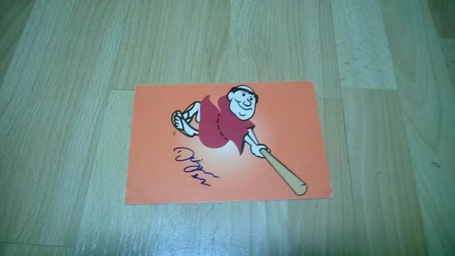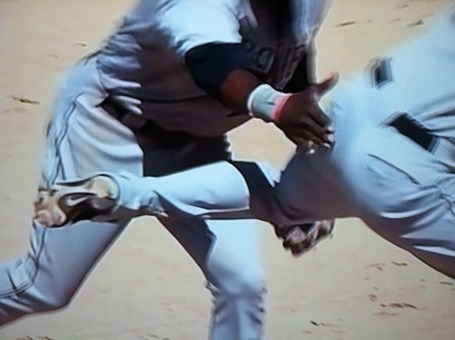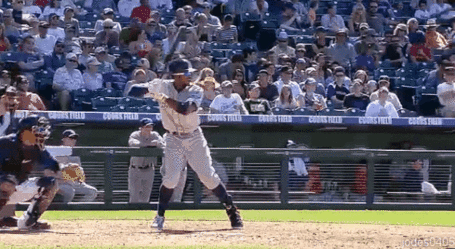
There is never a good time to get suspended for PEDs, but the worst time is probably after a breakout season on the cusp of a player's physical peak. Everth Cabrera and Yasmani Grandal were two of the rising stars taken down in the Biogenesis scandal. How much of their brilliant breakout seasons can we expect to see in the future with both players devoid of chemical enhancement?
The MLB instituted its first real drug policy in 2004. Since then we have a sample of 67 major leaguers who have been suspended for PED use, not to mention then-minor leaguers like our friends Clay Hensley, Matt Whiteside, Kevin Frandsen, and Jesus Guzman. Despite this, there isn't a huge list of comparables for guys like Everth Cabrera and Yasmani Grandal. Positive tests are not a representative sample for many reasons. A lot of PED users are not included because of changes in drug policy, like when Ryan Klesko stopped using ephedrine before the MLB banned it. Among players who were caught and continued to play we have to consider that the sample includes players recovering from catastrophic injury, since they have great incentive to use PEDs. PED use can also coincide with a once-great player's natural decline - the old guys and Viagra effect. Also, many on-the-bubble players on the cusp of the major leagues despite glaring flaws are tempted by PEDs.
Clay Hensley is a good example as one of those players. If you've forgotten about Clay Hensley, consider yourself the average Padres fan because there was virtually nothing memorable about his career other than giving up a big home run to some other guy who definitely, absolutely, did not maybe take steroids accidentally hey I thought that was a flu shot. Hensley was an 8th round pick out of college. In 2003 he was traded for Matt Herges, but eventually his confidence recovered. He was a middling prospect with average stuff, perhaps a bit too soft to stick in the majors. Hensley's velocity suddenly took a tick upwards, landing his sinker in the meaty 90-92 mph "hard sinker" range and he had a breakout year in 2005 for the AAA Portland Beavers, that same year he was suspended just 15 games for violating the PED policy. Hensley's velocity stayed in that effective range until he was in his 30s and natural decline began to set in. In exchange for that 15-game penance, a projected "AAAA player" like Hensley was able to use his newfound velocity to carve out a reasonably successful MLB career, hanging around for 7 years - which is 7 years longer than you've played, little buddy.
In addition to serving as an example of the pointlessness of the old MLB drug policy, Hensley's case illustrates the cumulative effect of anabolic steroids. I.e. with diet and training, athletes don't immediately lose the strength and muscle gains they made on steroids. Strength is the body's most general physical adaptation, and building muscle is very "expensive" in terms of using the body's resources. That's why it is a lot more difficult to build strength and muscle tissue than maintain it. The point being, there haven't been any examples of active players withering away and losing their strength after presumed cessation of PED use, though that cultural trope persists. Is this about batman?
Strength vs. Athleticism
Strength, being a very generalized physical adaptation, helps athletes in almost everything they do. That's why every athlete participates in strength training. However, it is important to differentiate strength from power. Power is the ability to generate force quickly, and is usually determined by a combination of strength (which is trained) and natural athleticism, or explosiveness (which is almost entirely inherited). This inborn ability is determined by a person's neuromuscular efficiency - nerve conduction velocity, ability to freely recruit fast-twitch muscle fibers, and other things that we don't really have a way of training. That's why a small guy like Billy Wagner can still throw a ball 100 miles an hour, or how 5'7 Spudd Webb can slam dunk. That's also why an incredible natural athlete like Will Venable hits for so much more power than the much bigger and stronger Yonder Alonso.
This distinction is central to talent evaluation in baseball. Ever wonder how scouts peg players like Rymer Liriano to have middle-of-the-order power when he's never hit more than 12 home runs in a season? That's his natural athleticism and captivating smile they are drooling over. Why do NFL scouts make quarterbacks perform the vertical jump test at the combine when you will never see Peyton Manning leap into the air on Sundays? Because the vertical jump is the best indicator of innate athleticism when you control for height and weight. An athlete who starts at 135lbs can probably double their squat with some hard work and coaching, but it is extremely rare to train more than 3-4" to a person's vertical jump. The vertical jump measures the output of the fabled "triple-extension" of the ankles, knees, and hips, fundamental to virtually every athletic activity - sprinting, jumping, tackling, throwing a punch, swinging a bat, etc.
Now, Everth Cabrera and Yasmani Grandal were both highly regarded for their athleticism as prospects. Shortstops are almost always superior athletes by the very nature of their position. Cabrera possesses great speed, awesome lateral quickness, and arm strength that makes you forget he's the smallest guy on the field whenever Alexi Amarista isn't playing. These aren't things you can fake with steroids. Grandal is just as innately talented. The first round of every MLB draft is full of athletic freaks of nature (many of whom never figure out the baseball part). As per his twitter, Grandal is also an avid boxer and crossfit athlete. Go ahead and watch it on mute if you don't want to be exposed to crossfad broscience.
Everth Cabrera
It's pretty safe to assume Everth Cabrera used HGH. As we've discussed before he admitted to using just prior to spring training to recover from injury. He didn't test positive for anything despite the fact that he was tested during spring training just like every other major leaguer. As we know HGH is undetectable under current MLB testing protocols, which means the "biogenesis products" E-Cab was suspended for must have been HGH or some unknown, undetectable PED.
At the risk of being naïve, I'm going to believe that Cabrera was a first-time user. Given the sincerity of his apology and genuine-seeming remorse, coupled with his diminutive stature and the fact that we've been watching him since he was a young Rule V draftee, I just can't see Everth as someone who has been using a PED like HGH in the long term. For the sake of offseason prognosticating, let's assume that he has come clean about all of his usage.
To determine whether or not his presumed cessation of HGH use will affect his success we need to determine what made him successful in 2013 versus his prior seasons in the big leagues.
| Batting line | bb% | k% | ISO | GB/FB | LD% | Chase% | Whiff% | Swing% | Contact% | BABiP | ||
| 2009-2012 | .240/.321/.327 | 9.6% | 22.4% | .086 | 2.8 | 18% | 25.5% | 7.8% | 40.9% | 80.4% | .318 | |
| 2013 | .283/.355/.381 | 9.4% | 15.9% | .097 | 3.19 | 20.6 | 27% | 5.4% | 40.1% | 86.5% | .337 |

He wrote "Don't come to your senses, swing for the fences" on the other side of this, then disappeared.
As we've discussed before, HGH is a relatively weak anabolic agent in comparison with other PEDs. Athletes favor HGH because of its regenerative properties and the fact that it is easily accessible while being impossible to detect in a traditional drug test. HGH is still heavily associated with bodybuilders and strength athletes despite the fact that it does very little to build strength in trained athletes. Its use in those sports is thought to be an accessory for heavy training regimes in tandem with other anabolic agents. Outside of the recovery effect, HGH is favored by endurance athletes and was allegedly administered to American cyclists before the Tour de France.
In light of this, it's hard to say Cabrera will experience a significant drop off in performance based on the physical effects of HGH cessation. The two most well-documented athletic uses for HGH are injury recovery (as cited in the Mitchell Report) and a general increase in stamina and endurance. I don't think anyone is going to claim Cabrera was using PEDs during the season since the Biogenesis story broke so early. Muscle gains made on HGH are relatively permanent, though it doesn't look like Everth has gained a whole lot of mass since 2009, certainly not an unnatural amount for an athlete in his prime years. Based on what we know about the effect of HGH and what we've seen on the field, it appears relatively safe to take Everth at his word - that he took PEDs to recover from an injury and that his 2013 is less of a drug-induced fever dream and more a young player reaching maturation and finally staying healthy. Does that mean we should expect another all-star performance from Cabby? I think we're seeing the talent that was always there, but it's going to be an uphill battle for any not-quite-established player in his position. I think the questions surrounding Cabrera's 2014 season are less about the physical effects of steroids and more of the traditional "breakout or career year" type storyline.
Yasmani Grandal
Grandal has received markedly less fan support than Cabrera since the breaking of the Biogenesis story. Grandal is obviously newer to the Padres organization and has been decidedly less vocal about the details of his suspension, even to the point of appearing standoffish. Coupled with the fact that he was acquired in exchange for the erratic but well-liked Mat Latos, Padres fans have been hard to please when it comes to the Cuban catcher. All this despite the fact that he has flashed all-star caliber potential at the big leagues and has raked at every level in the minors.
Grandal tested positive for testosterone, which has markedly different effects than HGH. As discussed, testosterone is allegedly the most popular illicit PED because of its long-term effect on energy levels, strength, muscle mass, stamina, endurance, and recovery from training and injury. All of these translate far more directly to athletic performance than HGH. That in and of itself should make Padres fans more nervous about Grandal's 2014 than Cabrera's. More strength means the ball will travel with more speed off of Grandal's bat when he makes contact, but it is an incremental gain.
Swinging a bat is an explosive movement that recruits explosive triple-extension of the hips, knees and ankles, with this force applied through the leverage of the arms and bat. The most common way to load and train explosive triple-extension is Olympic-style weightlifting, which is a prominent training modality in sports as diverse as baseball, football, sprinting, throwing, boxing, et al. Grandal can even be seen performing Olympic weightlifting variations in the video above. Olympic weightlifting itself is basically the sport of generating maximum athletic power in the classical lifts - the snatch and the clean & jerk. It is also historically rife with steroid use in a profound way. For these reasons, it is a great prism with which we can understand the effects of steroids on baseball players.
If you hate accordion music and fun, go ahead and skip the first minute of the video and watch a textbook example of and Olympic clean by medalist and former world champion Dmitry Klokov. Obviously, you're looking at a very strong athlete; however, the true separation between elite level weightlifters isn't the strength they possess, but the speed with which they can perform the triple-extension and pull themselves under the bar. Klokov is actually much stronger now than he was in the prime of his career, but with age came a natural decline in explosive athleticism. This phenomenon is also well-established in the MLB where explosive home run power is the first quality to fade in sluggers, even if the player puts on strength and muscle mass. In the 90s and 2000s, aging sluggers got around this by massively overcompensating the strength aspect of their training with powerful anabolics to the point of looking more like pro wrestlers than pro ballplayers.
What does this example mean for Yasmani Grandal? I think it means that you can expect some dropoff in his power (and the speed of his line drives and grounders), but nothing dramatic. Grandal's swing seems to have retained a lot of its good batspeed in 2013. Couple that with the fact that he's never been much of a power hitter and that the strength of his offensive game is really patience and strike zone management and I think you're still looking at a guy with a lot of offensive value.
"But 2013, that was a disaster! Doesn't that prove that there is a just God and cheaters never prosper?" In 2012, the ball was flying off of Grandal's bat - leading to an ultimately unsustainable .376 batting average on balls put in play. That number dipped dramatically to an awful .257 in 2013. That drop is probably not as dispositive as you think. BABiP is extremely prone to flukey variance, especially in tiny 100 PA samples. Like Leo DiCaprio in that movie about extremely slow-moving vans, we need to go deeper. The statistical batted-ball profile normalizes much sooner than BABiP because it generates much more descriptive data from a similarly sized sample. Generally a high BABiP hitter will also exhibit a very good line drive% and/or ground ball%. Extreme fly-ball hitters like Jose Bautista tend to also have very low BABiP numbers because they often give defenders a chance to camp under their balls, creepy Boy Scout leader.
Here's a comparison of Grandal's 2012 and 2013:
| GB% | LD% | FB% | Popup% | Home run ratio | |
| 2012 | 53% | 17% | 30% | 9% | 17% of fly balls were home runs |
| 2013 | 48% | 24% | 28% | 5% | 5% of fly balls were home runs |
Clearly, he continued to hit the ball with the meaty part of the bat, but apparently right at defenders. His batting average was backup-prom-date ugly. The numbers don't match up in a way that would seem sustainable. If he put up that kind of batted ball profile over the course of a full season he'd be a good bet to put up a solid batting average. The other good news is that Grandal's strike-zone management is otherworldly. He's drawn a walk in almost 15% of his MLB plate appearances, and has done a pretty good job of limiting strikeouts for a player who sees so many deep counts. If he had enough plate appearances to qualify, his walk rate would make him the 14th most patient hitter of the last decade. In his bizarre 2013 he had as many walks as strikeouts. There just is no record of someone with that good of a batting eye and hitting acumen fizzling out and becoming a below average hitter.
Grandal is not only a good athlete, but his game revolves around skills that are not directly aided by testosterone use, namely pitch recognition and anticipation. We know that testosterone use in healthy men actually inhibits spatial abilities. PEDs or not, it isn't fair to ask Grandal to repeat his unreal 2012 season. However, I don't think cessation of PEDs are going to derail Grandal's long-term career prospects - there's just too much to like. I'm more interested in seeing how he recovers from knee surgery and deals with all the negative fan and media attention.

